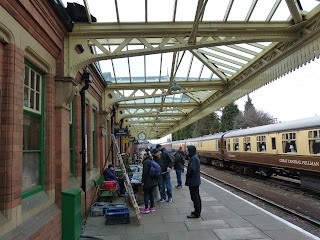For this final look at Leicester we have mainly put away the grand civic buildings and strayed into the more gritty world of commerce and industry. It is pleasing to see the number of clocks that still remain on such buildings, although some of them could do with some urgent love and attention.
But the gateway into this world is a church - St Peter's church on St Peter's Road. This is the Anglican St Peter's, not to be confused with the Catholic St Peter's elsewhere in the city, nor indeed with the one in the suburb of Belgrave (which I now realised I must of walked within 100 meters of without seeing it, and hence missing its clock)
This St Peter's had its foundation stone laid on 14 November 1872 and was consecrated on 18 April 1874. The architect was G E Street, most famous for the Royal Courts of Justice in London, but also designer of numerous churches and other buildings. For example, he also designed St Peter's churches in Little Aston, Helperthorpe, Swinton, Malvern, Chalvey, Filkins and Treverbyn.
We move now into the commercial world, if not yet into the industrial one. Sometimes you are just surprised by what you find when you go out looking. Walking along residential streets you turn a corner, and not only is there a clock which you weren't expecting to see, but it is nicely displayed on a pink building.
This is the offices of P A Todd & Company, Solicitors on the corner of East Park Road and Chesterfield Road. And thanks to their website (
www.patodd.co.uk) , I not only know that the company was formed in 1998 and moved into this building in 2014, I also know that this used to be the Evington Cinema.
Which helps to explain the unusual design of this building and its location.
Further research led me to Issue 258 (February / March 2016) of the Evington Echo (
www.evingtonecho.co.uk), which reveals that the cinema was opened in 1916 and closed in 1978. Following a fire in 1984, the main auditorium was demolished in 1989 and the site used for flats. So what we have today is just the frontage.
So we move on to another surprise. A mini-castle at the end of a cul-de-sac off a residential road.
I don't know anything about this building, except that I'm glad it's there.
More industry. This is St Saviour's Road.
Whilst the clock face on this side looks in good repair...
...that facing the road is not looking so good.
A little bit further along St Saviour's Road is the Corona Works building. This was home to Frederick Pollard & Co (as witnessed by the clock). Founded in 1911, the company specialised in the manufacture of drilling machinery.
Next up is this more modern clock on East Park Road.
This is the Vulcan Works in Vulcan Road. Built in 1876-78, it is supposedly the earliest engineering factory built in Leicester.
It was home , until 1986, of Gimson & Co, who amongst many other things built the beam engines at Abbey Pumping Station (see earlier post).
And finally, we visit the Haramead Business Centre, in Haramead Road.










































































